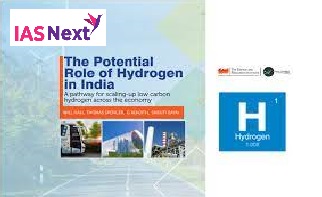CURRENT AFFAIRS
Get the most updated and recent current affair content on Padhaikaro.com
India and the Green Hydrogen Potential
- IAS NEXT, Lucknow
- 18, Feb 2022

Reference News:-
India, being a tropical country, has a significant edge in green hydrogen production due to its favourable geographic conditions and abundant natural resources.
- Producing hydrogen from renewables in India is likely to be cheaper than producing it from natural gas.
Need for:
- The vast majority of industrial hydrogen, about 70 metric tonnes (MT), is currently produced from natural gas through a conventional process known as steam methane reforming (SMR) with large quantities of by product CO2.
- The dependence on natural gas and coal means that hydrogen production today generates significant CO2 emissions.
Significance:
With the world seeking ways to accelerate the pace of transformation in the energy sector, India with the right policy support is in a unique position to not only become self-sufficient in green hydrogen but also produce green hydrogen for export markets.
- The focus on producing clean energy through green hydrogen is in line with the government’s goal of producing 450 GW of renewable energy by 2030 and, in the process, achieve emission goals under the Paris Agreement and reduce import dependency on fossil fuels.
Efforts by the government in this regard:
The Centre is planning to use the green hydrogen fuel from wastewater by using solar energy. It is possible by using electrolyzers.
How can this be achieved?
By segregation of solid waste management using the rooftop solar, we can make green hydrogen with the help of electrolysers. The power and water cost of producing it would be negligible. We can use this fuel even in railway engines along with cement and chemical companies instead of coal.
Challenges:
The path for green hydrogen in the country is not clear and at the moment, production of green hydrogen is slightly more expensive than grey hydrogen.
What is green hydrogen?
Hydrogen when produced by electrolysis using renewable energy is known as Green Hydrogen which has no carbon footprint.
Significance of Green Hydrogen:
- Green hydrogen energy is vital for India to meet its Nationally Determined Contribution (INDC) Targets and ensure regional and national energy security, access and availability.
- Green Hydrogen can act as an energy storage option, which would be essential to meet intermittencies (of renewable energy) in the future.
- In terms of mobility, for long distance mobilisations for either urban freight movement within cities and states or for passengers, Green Hydrogen can be used in railways, large ships, buses or trucks, etc.
Applications of green hydrogen:
- Green Chemicals like ammonia and methanol can directly be utilized in existing applications like fertilizers, mobility, power, chemicals, shipping etc.
- Green Hydrogen blending up to 10% may be adopted in CGD networks to gain widespread acceptance.
Benefits:
- It is a clean-burning molecule, which can decarbonize a range of sectors including iron and steel, chemicals, and transportation.
- Renewable energy that cannot be stored or used by the grid can be channelled to produce hydrogen.